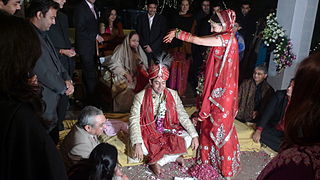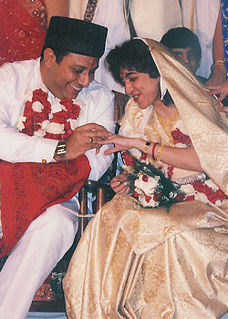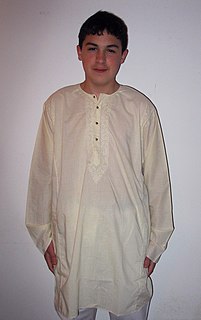
A wedding is a ceremony where two people are united in marriage. Wedding traditions and customs vary greatly between cultures, ethnic groups, religions, countries, and social classes. Most wedding ceremonies involve an exchange of marriage vows by the couple, presentation of a gift, and a public proclamation of marriage by an authority figure or celebrant. Special wedding garments are often worn, and the ceremony is sometimes followed by a wedding reception. Music, poetry, prayers or readings from religious texts or literature are also commonly incorporated into the ceremony, as well as superstitious customs originating in Ancient Rome.

An engagement, betrothal, or fiancer is a promise to wed, and also the period of time between a marriage proposal and a marriage. During this period, a couple is said to be betrothed,intended, affianced, engaged to be married, or simply engaged. Future brides and grooms may be called the betrothed, a wife-to-be or husband-to-be, fiancée or fiancé, respectively. The duration of the courtship varies vastly, and is largely dependent on cultural norms or upon the agreement of the parties involved.

Mehndi is a form of body art originating from the Indian subcontinent, in which decorative designs are created on a person's body, using a paste, created from the powdered dry leaves of the henna plant. Dating back to ancient India, mehndi is still a popular form of body art among the women of the Indian subcontinent, Africa and the Middle East.

Baraat is a groom's wedding procession in North India, West India and Pakistan. In North Indian communities, it is customary for the bridegroom to travel to the wedding venue on a mare, accompanied by his family members.

A Hindu wedding is Vivaha and the wedding ceremony is called Vivaah Sanskar in North India and Kalyanam (generally) in South India. Hindus attach a great deal of importance to marriage. The wedding ceremonies are very colourful, and celebrations may extend for several days. The bride's and groom's home—entrance, doors, wall, floor, roof—are sometimes decorated with colors, balloons, and other decorations.
Sakharpuda is the Maharashtrian Engagement ceremony. The correct name of the ceremony "Rupaya Naral - Sakharpuda". It is also known as "Waangnischay" which literally means verbal agreement.

The traditional Vietnamese wedding is one of the most important ceremonies in Vietnamese culture, which is influenced by Confucian and Buddhist ideologies.

This article is about the wedding in Bangladesh, for wedding in West Bengal, India, see: Bengali Hindu wedding.

Vivāha (Sanskrit) or Vivaah or Vivahamu is a word for marriage in the Indian subcontinent. The word originates as a sacred union of people as per Vedic traditions, i.e. what many call marriage, but based on cosmic laws and advanced ancient practices. Under Vedic Hindu traditions, marriage is viewed as one of the saṁskāras, which are lifelong commitments of one wife and one husband. In India, marriage has been looked upon as having been designed by the cosmos and considered as a "sacred oneness witnessed by fire itself." Hindu families are patrilocal.

An Ayyavazhi wedding is the wedding custom within the Ayyavazhi belief system of South India. Usually Payyans, Panividaiyalars from Thangals or an older person experienced in Ayyavazhi assumes a role as a Guru and is seated in the Manvarai for leading the wedding ceremony.

Marriage in Pakistan pertains to wedding traditions established and adhered by Pakistani men and women. Despite their local and regional variations, marriages in Pakistan generally follow Islamic marital jurisprudence. Culturally, marriages are not only seen as a union between a husband and a wife, but also an alliance between their respective families. These traditions extend to other countries around in the world where Overseas Pakistani communities exist.
Punjabi wedding traditions are a strong reflection of Punjabi culture with ritual, song, dance, food, and dress that have evolved over centuries.

Zoroastrian weddings are a religious ceremony in Zoroastrianism in which two individuals, a man and a woman are united. In Zoroastrianism, marriage within the community is encouraged, and is greatly favored in religious texts.
Ukrainian wedding is the traditional marriage ceremony in Ukrainian culture, both in Ukraine and in the Ukrainian diaspora. The traditional Ukrainian wedding featured a rich assortment of folk music and singing, dancing, and visual art, with rituals dating back to the pre-Christian era. Over time, the ancient pagan traditions and symbols were integrated into Christian ones.

Bengali Hindu wedding refers to Bengali wedding with Hindu rites and rituals native to the Indian subcontinent.
Hindu Wedding cards or invitations hallmark Hindu marriage rituals and customs which are entangled with eternal bonding, affection and blessing. The lavish traditions are highlighted with opulently colored Hindu wedding invitations aesthetically designed in handmade paper and designs enriched with heart-felt emotions. Hindu invitations symbolize glitter, lively mood and fun of the matrimonial ceremony. The Indian wedding cards are not only to inform and invite rather they express style and theme of the special day.

Indian wedding clothes are elaborate set of clothes worn by the bride, bridegroom and other relatives attending the wedding.
The Telugu Hindu wedding ceremony is the traditional wedding ceremony of the Telugu people in India. In the 19th century, the ceremony could last up to sixteen days. In modern times, it can last two or more days, depending on the family's financial and social status. The wedding ceremonies depend on the caste of the bride and groom. Each caste has its own customs with the upper castes engaging the Brahmin caste to performing their ceremonies while lower castes engage non Brahmins. The pendli or wedding is considered the strongest of social bonds, and is said to spiritually merge two souls opening the doors to gruhastaashramam. There is a Telugu saying that "Marriage is supposed to be a family union and not an individual formality.""
An Odia Hindu wedding, or bahaghara, is a wedding ceremony performed by Odia Hindu people in the Indian state of Odisha. There are subtle differences in the rites observed by different castes. In Odia marriage rituals the mother of the bridegroom does not take part in the ceremony. The Utkala Brahmins have their weddings only in the daytime, preferably at midday or in the morning, while the other caste weddings are done during the evening or night. There is the custom of sending betel nuts to family friends for inviting them to the marriage. The first invitation is sent to Jagannath as a respect to the lord. Marriages in Odisha are mostly fixed and arranged by the parents. Marriages for serving or capturing is not common. In the Odia community widow remarriage is allowed in some lower caste, in this case the younger brother is allowed to marry the deceased brother's wife. The marriage happens in three major rituals, Nirbandha, Bahaghara (wedding) and Chauthi/Chaturthi (consummation). A marriage is not considered complete or valid until consummation. These rituals are performed either at the Duara or Tola kanias house..



















